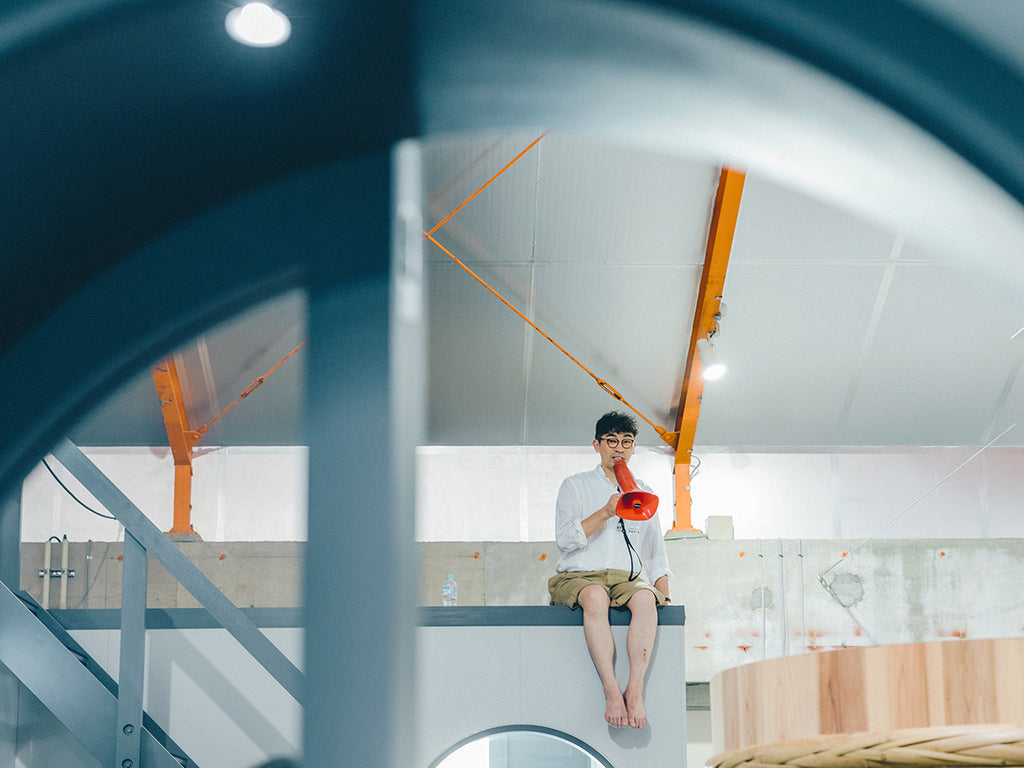田舎に暮らし始めると、「道の駅」が文字通り都会における鉄道の駅のように生活の一部になる。八百屋やスーパーと同様に普段の買い物をする場所だが、品揃えは訪れる度にけっこう違う。特に極端なのがフルーツで、いちごばかりが並んでいたと思ったら、青い梅が出てきて、スモモに桃、とこの時期は週ごとに品揃えが変わる。ただ、それが不便かというとそんなことはなく、あるものに従えばいいだけの話なのでかえって楽ともいえる。
一方、生産者にとっては自分の作ったものを売る場所でもある。生活の一部というならば、両方の立場から関わるのが筋だろう。ある日、レジで会計を済ませた後に、道の駅に生産物を置きたいと相談してみた。生産者と知り合いになりたいという思惑もある。
意外とあっさり。申し込み用の書類を渡される。一通り書いて提出すると、現場を見に来てくれて、問題なしと判断されたのか、600円で生産者用の帽子を買う。この帽子が裏の搬入口から出入りできる鍵になる。
さて、何を売ろうか。道の駅の人たちは蒸留酒を売ることを期待しているようだが、残念ながらまだタイミングではないし、むしろ違うものを置いてみたい。生活に必要か不要かよくわからない、でもあるとうれしいものを売れたらいいなと思う。

打ち合わせの合間にちょっと時間があったので、国立近代美術館で始まった ゴードン・マッタ=クラーク展を見に行く。家を真っ二つに切るビルディング・カットや、アーティストたちが運営する食堂「FOOD」などの活動は知っていたが、他のことははほとんど知らなかった。
町や社会にアートを介入させていくという作風で知られる彼も、1960年代後半、アーティストとして活動を始めた頃はギャラリーなどのスペースで普通に作品を展示していた。転機になったのは、ニューヨーク ソーホー、グリーン通り112番地の自主運営のアートスペース。様々なアーティストたちがサイトスペシフィックな作品を発表し、パフォーマンスを行う傍らで、彼は何を思ったかこのビルの地下室に引っ越し、穴を掘り始めた。ビルの重量を穴を掘ることで解き放つ、という意図で行われたそうだが、硬い地盤に阻まれて思ったほど穴は掘り進められない。しかし、その穴に桜の木を植えて展示をしたところ、地下室という閉鎖的な空間と、芽吹き花を咲かせる植物との対比が強烈な印象を残し評判になる。それから、彼は場所自体を作品の素材として考え始めたという。
図録を眺めていたら、「FOOD」のアイデアの元になったのは、彼が友人のアーティストの誕生日パーティに、花束ではなく食べられる花を持ってきたから、という記述があった。今でこそ馴染みのあるエディブルフラワーだが、当時は珍しかったのかもしれない。飾るだけではなく食べられる、食べられるだけじゃなくて飾れる。一輪の花がいくつかの役割を持ち、それを自分たちの環境に置きかえ、自分たちが働きながら食べられるレストランが生まれた。その会話を想像し、発想の飛躍にワクワクする。

社会的な立ち位置を語られることが多い「FOOD」だが、ゴードン・マッタ=クラークにとっては、食べ終わった動物の骨をネックレスへとリサイクルしたり、生きたエビを供するなど、食べ物を使ったアートショウを行うという一面もあった。
食事の共同性ももちろん大切だが、ただ皆で食べればいいのかというと、それでは学校の給食と変わりない。
作る人、使う素材と提供するメニュー、集う人、場所の設え、地域との関わり。それぞれに工夫があるのが理想だが、経済活動という大きな壁も存在する。
ここまで書いて、道の駅で何を納品するのがいいのか、と考えは戻る。

6月はクラウドファンディングのリターンの「蒸留所ツアー」の準備に多くの時間を費やした。月末には4日に分けて計300名もの人たちがはじめてmitosayaを訪れる。関わっている人たちと、限られた時間の中でやることを取捨すると、必然的にそれぞれが何を大切にしているかが見えてくる。
ある人は入口にサインをつけたいと、ネオン業者を探してこの日までに取り付けまで行おうと奔走する。ある人は名刺を作りたいという。ある人は来場者に快適に行き来してもらうために都内から貸切バスを手配したいという。ある人はどんな飲み物、食べ物を提供しようかと考える。そして僕は蒸留所として稼働する様子が少しでも伝わるように設備を整えたい。

あとは来た人が飲んだり食べたりできるように80名分のテーブルと椅子を用意しなくてはならない。困っていたら、ドイツからちょうど届いたコンテナが目に入った。持ち帰ろうとしる配送業者のおじさんに手伝ってもらい、クレートコンテナをバラしてテーブルの天板に、ガラスのフラスコが入っていた木枠をテーブルの脚にすることにした。





さらに、せっかくだから何か配るものを作りたい。僕以外のmitosayaに関わっている人に案内文を書いてもらった。改めて読むと、内容は見事に違っていて、それぞれが何を考えているのかがよくわかる(結果何が起こるかはまだわからない)。
こうして行われたツアーに来てくれた人は喜んでくれたんじゃないかと思う。
自分たちしかいなかった場所に、徐々に人が集まりはじめる。マッタ=クラークの食べられる花のような、前向きな予想外のきっかけを提供できる場所になれたらいいなと思う。
When you start living in the countryside, "Michi-no-Eki" literally becomes a part of your life, like a train station in the city. It is a place where you do your daily shopping, just like a grocery store or a supermarket, but the selection varies considerably every time you visit. The most extreme is the fruit selection, which changes weekly during this season, from strawberries, to green plums, to plums and peaches. However, this does not mean that it is inconvenient, but rather that it is easier to just follow what is available.
On the other hand, it is also a place for producers to sell their products. If it is a part of our lives, it makes sense to be involved from both perspectives. One day, after paying the bill at the cash register, I asked about placing my products at the roadside station. I also wanted to get to know the producers.
It was surprisingly easy. I was handed an application form. After I filled out the application form and submitted it, they came to check the site and decided that there was no problem, so I bought a hat for the producer for 600 yen. This hat is the key to get in and out of the back loading bay.
Now, what should I sell? The people at the roadside station seem to be expecting me to sell spirits, but unfortunately it's not the right time yet, and I'd rather try something different. I'd like to sell things that I don't really know if I need or don't need in my life, but that would be nice to have.

I had some time in between meetings, so I went to see the Gordon Matta-Clark exhibition that opened at the National Museum of Modern Art. I knew about the activities of Building Cuts, where a house is cut in half, and FOOD, a cafeteria run by the artists, but I knew very little about the rest.
He was known for his style of intervening art in towns and society, and when he started his career as an artist in the late 1960s, he exhibited his works in ordinary spaces such as galleries. The turning point for him came at a self-managed art space at 112 Greene Street in Soho, New York. While various artists were presenting site-specific works and performances, he had the idea to move into the basement of the building and started digging a hole. The intention was to release the weight of the building by digging a hole, but the hard ground prevented him from digging as far as he thought he could. However, when he planted a cherry tree in the hole and exhibited it, the contrast between the closed space of the basement and the budding and blooming plants left a strong impression and became popular. The contrast between the enclosed space of the basement and the budding and blooming plants left a strong impression and was well received. After that, he began to consider the place itself as a material for his works.
Looking at the catalogue, I read that the idea for "food" came from a friend of his who brought edible flowers instead of a bouquet to an artist's birthday party. Edible flowers are familiar to us now, but they may have been rare at the time. They could be eaten as well as displayed, not only eaten but also displayed. A single flower has several roles, and by replacing it with our own environment, a restaurant was born where we can eat while we work. I imagine this conversation and am thrilled by the leap in ideas.

FOOD" is often talked about in terms of its social position, but for Gordon Matta-Clark, it was also an aspect of an art show using food, such as recycling finished animal bones into necklaces and offering live shrimp.
Of course, the communal nature of the meal is important, but if we just eat together, it is no different from a school lunch.
The ideal situation is one where there is ingenuity on the part of the cook, the ingredients used, the menu served, the people who gather, the setting, and the relationship with the community. Ideally, there should be ingenuity in each of these areas, but there is also the huge barrier of economic activity.
Now that I've written this, I'm back to thinking about what to deliver at a roadside station.

In June, I spent a lot of time preparing for the "distillery tour" as a return for the crowdfunding. At the end of June, a total of 300 people visited mitosaya for the first time over four separate days. As we tried to decide what to do in the limited time we had with the people involved, we inevitably found out what each person cared about.
One person wanted to put up a sign at the entrance, so he scrambled to find a neon sign contractor and get it installed by this date. One person wanted to make business cards. One person wanted to arrange a chartered bus from Tokyo so that visitors could get to and from the event comfortably. Some wanted to think about what kind of drinks and food to serve. And I want to set up the facilities so that people can see the distillery in operation as much as possible.

I also need to set up tables and chairs for 80 people so that people can come and drink and eat. While I was having trouble, I saw a container that had just arrived from Germany. With the help of the delivery man, I decided to take the crate container apart and use it as the table top, and the wooden frame that contained the glass flask as the table legs.





Furthermore, I wanted to make something to hand out. I asked other people who were involved in mitosaya to write a guide. When I read it again, the contents were very different, and I could understand what each person was thinking (I still don't know what will happen as a result).
I think the people who came to the tour that took place in this way must have been pleased.
Gradually, people began to gather in a place where we were the only ones there. I hope we can become a place that can provide positive and unexpected opportunities, like Matta-Clark's edible flowers.




